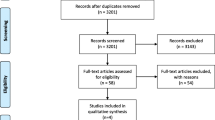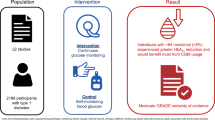Abstract
Introduction
The objective of this study is to conduct an assessment of Remote Patient Monitoring (RPM) systems compared to usual care for controlling glycosylated hemoglobin in type 2 diabetes.
Methods
The study was a systematic review with meta-analysis and meta-regression. A systematic search was performed via the most important electronic databases of medical resources, such as PubMed, Scopus and Cochrane library. The main outcome was HbA1C. The heterogeneity sources were examined using Chi-square (Q) and I2 tests. Meta-analyses were done using Stata version 11 software. Statistical significance was defined as P < 0.05. Random effects model was used in meta-analysis, and the heterogeneity more than 50% was considered as significant.
Results
The results of the systematic review and meta-analysis indicated that the effect size index (Difference of Pre-test/Post-test Control Design-2nd method “using pooled pretest SD” (DPPC2)) among users of RPM for type 2 diabetic patients was −0.32 with a confidence interval of 95% (from −0.45 to −0.19) as compared to the control group. The current study declared a vital role of RPM technology in reduction of hemoglobin glycogen levels. The results of the subgroup analysis showed that RPM is more effective for patients who are residents of cities, having intervention lengths less than 6 months, getting the orders from the physician and using the websites as their intervention type.
Conclusion
The current study indicted the efficacy of RPM in reducing HbA1c among type 2 diabetic patients, which could be a base for policymakers to decide on the introduction of this technology in Iran.







Similar content being viewed by others
References
Logan AG, McIsaac WJ, Tisler A, Irvine MJ, Saunders A, Dunai A, et al. Mobile phone–based remote patient monitoring system for management of hypertension in diabetic patients. Am J Hypertens. 2007;20(9):942–8.
Organization WH. Global report on diabetes: World Health Organization. Geneva; 2016.
Control CD. Prevention. National diabetes statistics report, 2017. Centers for Disease Control and Prevention, US Department of Health and Human Services.: Atlanta, GA; 2017.
Fathi ahmadsaraei N, Neshat doost HT, Manshaee GR, Nadi MA. The Effectiveness of Acceptance and Commitment Therapy on Quality of Life among Patients with Type 2 Diabetes. Iranian Journal of Health Education and Health Promotion. 2016;4(1):31–9.
Whiting DR, Guariguata L, Weil C, Shaw J. IDF diabetes atlas: global estimates of the prevalence of diabetes for 2011 and 2030. Diabetes Res Clin Pract. 2011;94(3):311–21.
Organization WH. Use of glycated haemoglobin (HbA1c) in diagnosis of diabetes mellitus: abbreviated report of a WHO consultation. Geneva: World Health Organization; 2011.
Holl F, Munteh P, Burk R, Swoboda W. Improving access to care in rural Africa through the use of telemedicine: Using a mHealth system as a case study. Studies in health technology and informatics. 2017;244:105.
Vegesna A, Tran M, Angelaccio M, Arcona S. Remote patient monitoring via non-invasive digital technologies: a systematic review. Telemedicine and e-Health. 2017;23(1):3–17.
Chase HP, Pearson JA, Wightman C, Roberts MD, Oderberg AD, Garg SK. Modem transmission of glucose values reduces the costs and need for clinic visits. Diabetes Care. 2003;26(5):1475–9.
Bonsignore L, Bloom N, Steinhauser K, Nichols R, Allen T, Twaddle M, et al. Evaluating the Feasibility and Acceptability of a Telehealth Program in a Rural Palliative Care Population: TapCloud for Palliative Care. J Pain Symptom Manag. 2018.
Yoo B-K, Kim M, Sasaki T, Hoch JS, Marcin JP. Selected use of telemedicine in intensive care units based on severity of illness improves cost-effectiveness. Telemedicine and e-Health. 2018;24(1):21–36.
Smith NM, Satyshur RD. Pediatric diabetes telemedicine program improves access to care for rural families: role of APRNs. Pediatr Nurs. 2016;42(6):294.
Noah B, Keller MS, Mosadeghi S, Stein L, Johl S, Delshad S, et al. Impact of remote patient monitoring on clinical outcomes: an updated meta-analysis of randomized controlled trials. NPJ Digital Medicine. 2018;1(1):2.
Wilson LS, Maeder AJ. Recent directions in telemedicine: review of trends in research and practice. Healthcare informatics research. 2015;21(4):213–22.
Bayliss EA, Steiner JF, Fernald DH, Crane LA, Main DS. Descriptions of barriers to self-care by persons with comorbid chronic diseases. The Annals of Family Medicine. 2003;1(1):15–21.
Coye MJ, Haselkorn A, DeMello S. Remote patient management: technology-enabled innovation and evolving business models for chronic disease care. Health Aff. 2009;28(1):126–35.
community Tgd. Blood Glucose Care. 2018. https://www.diabetes.co.uk/what-is-hba1c.html
Riazi H, Larijani B, Langarizadeh M, Shahmoradi L. Managing diabetes mellitus using information technology: a systematic review. Journal of Diabetes & Metabolic Disorders. 2015;14(1):49.
Onkar Sumant PJ. Remote Patient Monitoring Market by Condition (Congestive Heart Failure, Diabetes, Chronic Obstructive Pulmonary Disease, Blood Pressure, and Mental Health), Components (Devices and Software) - Global Opportunity Analysis and Industry Forecast, 2014 - 2022. 2016.
Global Remote Patient Monitoring Systems Market. 2017.
Baum P, Abadie F, Lupiañez FV, Maghiros I, Mora EV, Talaya MBZ. Market Developments–Remote Patient Monitoring and Treatment, Telecare, Fitness/Wellness and mHealth. Strategic Intelligence Monitor on Personal Health Systems, Phase. 2013;2.
Hossain MS, editor. Patient status monitoring for smart home healthcare. Multimedia & Expo Workshops (ICMEW), 2016 IEEE International Conference on; 2016: IEEE.
Mack H. Remote patient monitoring market grew by 44 percent in 2016, report says. 2017. http://www.mobihealthnews.com/content/remote-patient-monitoring-market-grew-44-percent-2016-report-says.
Moher D, Liberati A, Tetzlaff J, Altman DG, Group P. Preferred reporting items for systematic reviews and meta-analyses: the PRISMA statement. 2010.
Morris SB. Estimating effect sizes from pretest-posttest-control group designs. Organ Res Methods. 2008;11(2):364–86.
Kwon H-S, Cho J-H, Kim H-S, Song B-R, Ko S-H, Lee J-M, et al. Establishment of blood glucose monitoring system using the internet. Diabetes Care. 2004;27(2):478–83.
Cho J-H, Chang S-A, Kwon H-S, Choi Y-H, Ko S-H, Moon S-D, et al. Long-term effect of the Internet-based glucose monitoring system on HbA1c reduction and glucose stability: a 30-month follow-up study for diabetes management with a ubiquitous medical care system. Diabetes Care. 2006;29(12):2625–31.
Shea S, Weinstock RS, Starren J, Teresi J, Palmas W, Field L, et al. A randomized trial comparing telemedicine case management with usual care in older, ethnically diverse, medically underserved patients with diabetes mellitus. J Am Med Inform Assoc. 2006;13(1):40–51.
Tildesley HD, Mazanderani AB, Ross SA. Effect of Internet therapeutic intervention on A1C levels in patients with type 2 diabetes treated with insulin. Diabetes Care. 2010;33(8):1738–40.
Quinn CC, Shardell MD, Terrin ML, Barr EA, Ballew SH, Gruber-Baldini AL. Cluster-randomized trial of a mobile phone personalized behavioral intervention for blood glucose control. Diabetes Care. 2011;34(9):1934–42.
Kleinman NJ, Shah A, Shah S, Phatak S, Viswanathan V. Improved medication adherence and frequency of blood glucose self-testing using an m-Health platform versus usual care in a multisite randomized clinical trial among people with type 2 diabetes in India. Telemedicine and e-Health. 2017;23(9):733–40.
Warren R, Carlisle K, Mihala G, Scuffham PA. Effects of telemonitoring on glycaemic control and healthcare costs in type 2 diabetes: a randomised controlled trial. J Telemed Telecare. 2018;24(9):586–95.
Bujnowska-Fedak MM, Puchała E, Steciwko A. The impact of telehome care on health status and quality of life among patients with diabetes in a primary care setting in Poland. Telemedicine and e-Health. 2011;17(3):153–63.
Tang PC, Overhage JM, Chan AS, Brown NL, Aghighi B, Entwistle MP, et al. Online disease management of diabetes: engaging and motivating patients online with enhanced resources-diabetes (EMPOWER-D), a randomized controlled trial. J Am Med Inform Assoc. 2012;20(3):526–34.
Istepanian RS, Mousa A, Haddad N, Sungoor A, Hammadan T, Soran H et al., editors. The potential of m-health systems for diabetes management in post conflict regions a case study from Iraq. 2014 36th Annual International Conference of the IEEE Engineering in Medicine and Biology Society; 2014: IEEE.
Steventon A, Bardsley M, Doll H, Tuckey E, Newman SP. Effect of telehealth on glycaemic control: analysis of patients with type 2 diabetes in the Whole Systems Demonstrator cluster randomised trial. BMC Health Serv Res. 2014;14(1):334.
Wakefield BJ, Koopman RJ, Keplinger LE, Bomar M, Bernt B, Johanning JL, et al. Effect of home telemonitoring on glycemic and blood pressure control in primary care clinic patients with diabetes. Telemedicine and e-Health. 2014;20(3):199–205.
Fountoulakis S, Papanastasiou L, Gryparis A, Markou A, Piaditis G. Impact and duration effect of telemonitoring on HbA1c, BMI and cost in insulin-treated Diabetes Mellitus patients with inadequate glycemic control: A randomized controlled study. Hormones. 2015;14(4):632–43.
Zhai Y-k, Zhu W-j, Cai Y-l, Sun D-x, Zhao J. Clinical-and cost-effectiveness of telemedicine in type 2 diabetes mellitus: a systematic review and meta-analysis. Medicine. 2014;93(28).
Nicolucci A, Cercone S, Chiriatti A, Muscas F, Gensini G, Group RS. A randomized trial on home telemonitoring for the management of metabolic and cardiovascular risk in patients with type 2 diabetes. Diabetes Technol Ther. 2015;17(8):563–70.
Alotaibi MM, Istepanian R, Philip N. A mobile diabetes management and educational system for type-2 diabetics in Saudi Arabia (SAED). mHealth. 2016;2:33. https://doi.org/10.21037/mhealth.2016.08.01.
Anzaldo-Campos MC, Contreras S, Vargas-Ojeda A, Menchaca-Diaz R, Fortmann A, Philis-Tsimikas A. Dulce Wireless Tijuana: a Randomized Control Trial Evaluating the Impact of Project Dulce and Short-Term Mobile Technology on Glycemic Control in a Family Medicine Clinic in Northern Mexico. Diabetes Technol Ther. 2016;18(4):240–51. https://doi.org/10.1089/dia.2015.0283.
Holmen H, Torbjørnsen A, Wahl AK, Jenum AK, Småstuen MC, Årsand E, et al. A mobile health intervention for self-management and lifestyle change for persons with type 2 diabetes, part 2: One-year results from the Norwegian randomized controlled trial RENEWING HEALTH. Diabetes Technology and Therapeutics. 2016;18:S58–S9. https://doi.org/10.1089/dia.2016.2506.
Kim HS, Sun C, Yang SJ, Sun L, Li F, Choi IY, et al. Randomized, Open-Label, Parallel Group Study to Evaluate the Effect of Internet-Based Glucose Management System on Subjects with Diabetes in China. Telemedicine and e-Health. 2016;22(8):666–74. https://doi.org/10.1089/tmj.2015.0170.
Cho JH, Kim HS, Yoo SH, Jung CH, Lee WJ, Park CY, et al. An Internet-based health gateway device for interactive communication and automatic data uploading: Clinical efficacy for type 2 diabetes in a multi-centre trial. J Telemed Telecare. 2017;23(6):595–604. https://doi.org/10.1177/1357633X16657500.
Dario C, Toffanin R, Calcaterra F, Saccavini C, Stafylas P, Mancin S, et al. Telemonitoring of Type 2 Diabetes Mellitus in Italy. Telemedicine journal and e-health: the official journal of the American Telemedicine Association. 2017;23(2):143–52. https://doi.org/10.1089/tmj.2015.0224.
Kitsiou S, Pare G, Jaana M, Gerber B. Effectiveness of mHealth interventions for patients with diabetes: an overview of systematic reviews. PLoS One. 2017;12(3):e0173160.
Saffari M, Ghanizadeh G, Koenig HG. Health education via mobile text messaging for glycemic control in adults with type 2 diabetes: a systematic review and meta-analysis. Primary care diabetes. 2014;8(4):275–85.
Shabaninejad H, Sarikhani M, Asgharzadeh A. Investigating the effect of providing care thrugh a text message of a cell phone in comparison with the face-to-face approach for controlling blood glucose (HBA1C) in patients with type 2 diabetes: A systematic review and analysis of meta_regression. Iranian Journal of Diabetes and Metabolism. 2018;17(6):272–84.
Acknowledgments
This research was part of MSc thesis on Health Technology Assessment, which was approved by school of public health, Tehran University of medical Sciences.
Author information
Authors and Affiliations
Corresponding author
Additional information
Publisher’s note
Springer Nature remains neutral with regard to jurisdictional claims in published maps and institutional affiliations.
Rights and permissions
About this article
Cite this article
Salehi, S., Olyaeemanesh, A., Mobinizadeh, M. et al. Assessment of remote patient monitoring (RPM) systems for patients with type 2 diabetes: a systematic review and meta-analysis. J Diabetes Metab Disord 19, 115–127 (2020). https://doi.org/10.1007/s40200-019-00482-3
Received:
Accepted:
Published:
Issue Date:
DOI: https://doi.org/10.1007/s40200-019-00482-3




